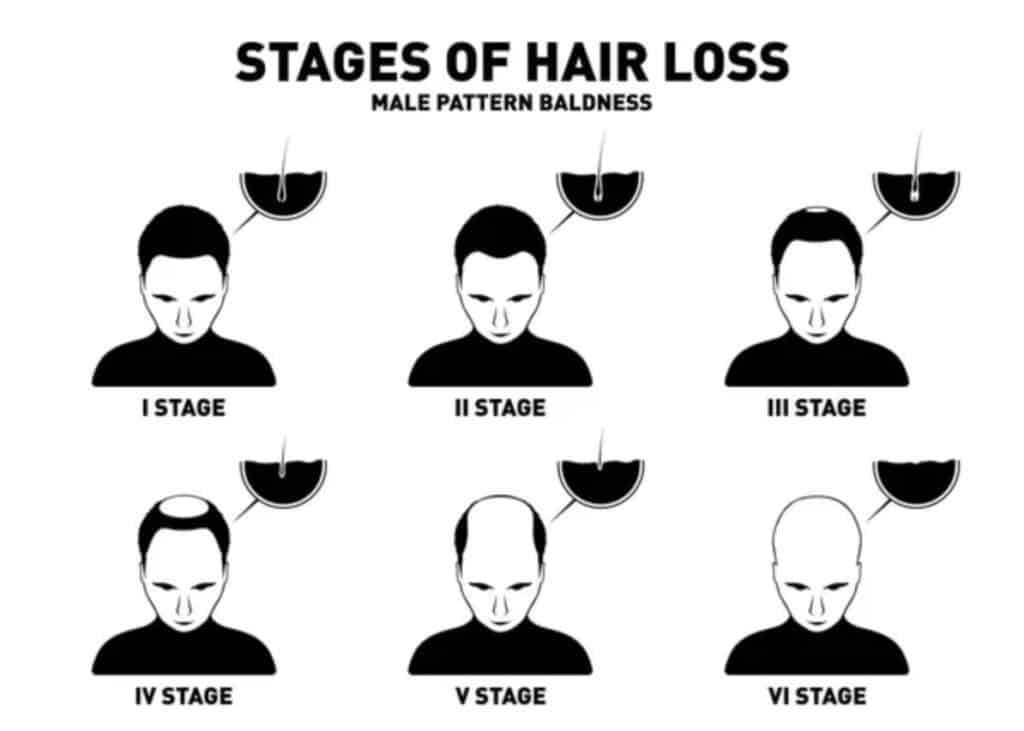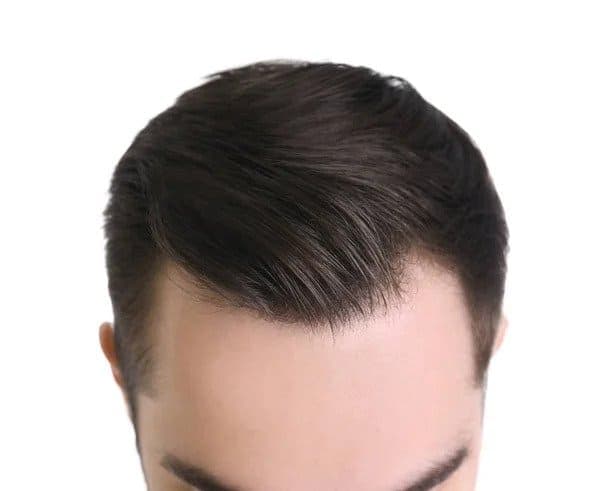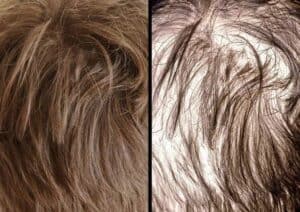If you’re suffering with a receding hairline, then you have probably heard of the “m shaped hairline”. On this page you’ll find out everything you need to know about m shaped hairlines: how to spot one, how to treat one, and how to tackle hair loss.
Overview
An “m shaped” hairline is a common feature in men’s hair. Although it is sometimes indicative of a condition called male pattern baldness (androgenetic alopecia), this is not only the case. For around half of all men, the m shaped hairline is a sign of a fully mature hairline. Many people who are unhappy about their m shaped hairline look to treat this with an FUE hair transplant.
What is an M Shaped Hairline?
 Simply put, an “m shaped” hairline refers to the shape of the hairline commonly found in men’s hair. The m shape is found on the hairline (front of the head) and is characterised by a protruding frontal section of hair and temple recession.
Simply put, an “m shaped” hairline refers to the shape of the hairline commonly found in men’s hair. The m shape is found on the hairline (front of the head) and is characterised by a protruding frontal section of hair and temple recession.
The m shaped hairline is usually linked to a condition called male pattern baldness (or male pattern hair loss). This is where men lose hair in accordance with the Hamilton-Norwood Scale, beginning with temple recession (the m-shaped hairline), graduating onto balding on the crown, and eventually continuing to total baldness on top.
In some cases, like the “widow’s peak”, the m shaped hairline may simply be a sign of a mature hairline that will not continue to recede in the future. The hairline will usually mature between 17-30 years old. So, if you’re around this age, your m shaped hairline may be mature hairline and not a sign of male pattern baldness.
Celebrities with the m shaped hairline include, but are not limited to: Harry Styles, Chris Hemsworth, Jude Law, and Daniel Craig.
How Do I Know I Have an M Shaped Hairline?
An m shaped hairline is easy to spot. Take a look at yourself face on in any mirror. If you see a gradual curve from the frontal section of hair and a gradual recession into the temple area, then you will likely have an m shaped hairline.
What makes an m shaped hairline extremely noticeable (when compared with a widow’s peak) is the steeper angle of curvature with which recession may occur. If you simply have a widow’s peak, your hairline will look visibly straighter and create a “v shape” rather than an “m”.
Another giveaway that you have an m shaped hairline rather than widow’s peak hairline would be that you are suffering with noticeable hair loss. If you are losing hair on your hairline at a faster rate than you can grow it back, then this would be indicative of a receding hairline, as opposed to a maturing hairline. Hair thinning across the frontal hairline would also be a major indicator of an m-shaped hairline.
What’s the Difference Between an M Shaped Hairline and a Widow’s Peak Hairline?
There are two major differences between m shaped hairlines and widow’s peak hairlines: appearance, and causes.
As stated in the section above, the main difference between the m shaped hairline and widow’s peak hairline is the curvature of the hairline across the front of the head. The widow’s peak hairline shows a gradual curve (if at all) from the centre of the hairline to either side point. A good example of this would be a hairline like Henry Cavill or Gary Cooper.
The m-shaped hairline has a much steeper curvature from frontal section to either side. In most cases, this will also posit a large area of temple recession. This brings us nicely on to causes.
The cause of an m shaped hairline, in almost all cases, is male pattern baldness. Not only will this cause visible temple recession and a receding hairline, it may worsen into crown thinning, or total hair loss across the top of the head. However, a widow’s peak is not always a sign of hair loss. Rather, it is often a sign of a mature hairline that is not expected to recede with age.
To also mention some minor differences between the two, an m shaped hairline will only ever affect male patients. On the other hand, there are plenty of women who have a widow’s peak. Kourtney Kardashian or Nicole Kidman both have a widow’s peak hairline.
What Causes an M Shaped Hairline?
M shaped hairlines are usually associated with a number of hair loss conditions. The causes of this hair loss are usually put down to some of the following causes:
Genetics – Male Pattern Baldness

One of the most common causes of an m shaped hairline is a condition called male pattern baldness. This is inherited from the mother’s side of your genetic makeup and usually posits itself as a receding hairline in men.
Interestingly, female pattern baldness does not cause hair loss in the same area as male pattern hair loss. Whilst men may develop a gradual m shaped hairline, women tend to thin over the mid-parting area. Women can track their pattern hair loss using the Ludwig Scale.
Male pattern baldness can not only leave patients with an m shaped hairline. Over time, a new type of hairline may develop, where the hair thins across the frontal section as well. Eventually, all of this hair may recede causing a “u shaped hairline”.
Hormones – Dihydrotestosterone
As well as genetic explanations, hair loss occurs in the male body as a result of hormonal changes in the body. Dihydrotestosterone (DHT) is the hormone responsible for hair loss in men. DHT and hair loss is a hotly contested topic of debate in scientific communities. However, it almost certainly plays an important role in the formation of an m shaped, or receding hairline.
DHT molecules in the body bind to androgen receptors on the hair follicles in the hairline, causing hair loss. In most cases, this will occur in a patterned way, worsening symptoms of male pattern hair loss. So, DHT may be one of the leading causes of an m shaped hairline.
Environment – Telogen Effluvium
As well as genetic and hormonal causes, environmental conditions such as telogen effluvium may cause an m shaped hairline. Simply put, telogen effluvium is referred to as the excessive shedding of resting (or telogen phase) hair follicles. Usually, this happens after a person suffers with metabolic stress, hormonal changes, or medication.
If you are already suffering with pattern baldness, then telogen effluvium may worsen the effects of an m shaped or receding hairline.
Do I Need to Take Medication For My M Shaped Hairline?
For people suffering with m shaped or receding hairlines, there are a number of precautions you can take. If you’re suffering with the early signs of an m shaped or receding hairline, then you can consider the following medication:
Taking medication to combat your receding hairline is one of the first steps you can take. Whilst these hair loss medications will not help to reshape and regrow your hairline, they do perform a vital role in slowing down further hair loss and preventing recession into a u shape.
How Can I Fix My M Shaped Hairline?
If you’re looking to fix your m shaped hair loss for good, then the only way to truly fix this is through hair transplantation. Hair transplant procedures, nowadays follicular unit extraction (FUE) and direct hair implantation (DHI) methods, look to redistribute healthy hair follicles from your donor area (usually from the back or sides of the head) and implant these donor hairs in the recipient site.

In the case of patients with an m shaped or receding hairline, they would need a hairline hair transplant surgery. Usually using around 1,200 to 2,200 grafts, the aim of a hairline hair transplant is to reshape the hairline to give it a lovely straight look and bolster the area behind the hairline where a patient may have suffered with temple recession.
If you’re looking to combat your m shaped hairline with a hair transplant and regain a “normal” hairline, then feel free to book your free consultation.
Frequently Asked Questions
If your hairline recedes further than just an “M” shape, it typically indicates more advanced male pattern baldness or a more significant degree of hair loss. When this happens, the “M” shape can evolve into a more pronounced receding hairline or even balding at the crown. In extreme cases you may even see a “u” shape.
Yes, an m shaped hairline is a natural hairline. The main thing to note is that this type of hairline is often seen in those with a genetic predisposition to pattern baldness. The specific pattern of a person’s hairline can vary based on their genetics, and a receding or “M-shaped” hairline can be considered a natural expression of that genetic predisposition.
The m shaped hairline is a common and normal occurrence in many men as they age, and definitely shouldn’t be anything to worry about.
An “M-shaped” hairline, also known as a receding hairline, is primarily associated with male pattern baldness (androgenetic alopecia) and is much more common in men than in women. Male pattern baldness typically starts with a recession of the hairline, which can create an “M” or “widow’s peak” shape, followed by thinning or balding at the crown of the head.
While women can experience pattern hair loss, it often presents differently from male pattern baldness. In women, hair loss tends to be more diffuse, affecting the entire scalp rather than following a specific pattern like the “M” shape seen in men. Female pattern hair loss, for example, usually leads to overall thinning of the hair without a noticeable receding, or m shaped hairline.
If you have a receding or m shaped hairline and would like to choose a haircut that helps conceal or minimise its appearance, several hairstyle options can be flattering. Keep in mind that no haircut can completely hide a receding hairline, but the right style can draw attention away from it.
Here are some of the hairstyles we recommend if you’re self conscious about your m shaped hairline: short buzz cut, crew cut, undercut, textured crop, combover, fringe, short pompadour and/or a bald head.








